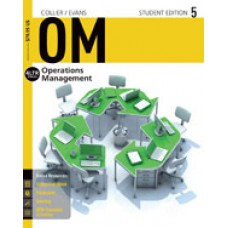Test Bank for OM 5, 5th Edition

Product details:
- ISBN-10 : 1285451376
- ISBN-13 : 978-1285451374
- Author: David A. Collier
Created through a “student-tested, faculty-approved” review process with input from more than 150 students and faculty, Collier/Evans’ OM5 provides a streamlined introduction to the core concepts, techniques, and applications of contemporary operations management. This concise, engaging, and accessible text includes a full suite of integrated learning tools–including flashcards, cases, datasets, games, and quizzes–in a convenient and affordable package perfect for today’s diverse learners. OM5 provides the latest examples featuring companies students will recognize from the news as well as videos for every chapter, case studies and end-of-chapter problems with exciting new material online. Five additional chapters online enable readers to delve further into the quantitative aspects of operations management.
Table contents:
- Ch 1: Goods, Services, and Operations Management
- Ch 1: Learning Outcomes
- 1-1: Operations Management
- 1-2: OM in the Workplace
- 1-3: Understanding Goods and Services
- 1-4: Customer Benefit Packages
- 1-5: Processes
- 1-6: OM: A History of Change and Challenge
- 1-7: Current Challenges in OM
- Ch 1: Discussion Questions
- Ch 1: Problems and Activities
- Ch 1: Zappos Case Study
- Ch 2: Value Chains
- Ch 2: Learning Outcomes
- Ch 2: Introduction
- 2-1: The Concept of Value
- 2-2: Value Chain Paradigms and Perspectives
- 2-3: Value Chain Decisions
- 2-4: Offshoring and Reshoring
- 2-5: Value Chains in a Global Business Environment
- 2-6: Sustainable Value Chains
- Ch 2: Discussion Questions
- Ch 2: Problems and Activities
- Ch 2: Bookmaster Case Study
- Ch 3: Measuring Performance in Operations
- Ch 3: Learning Outcomes
- Ch 3: Introduction
- 3-1: Types of Performance Measures
- 3-2: Analytics in Operations Management
- 3-3: Designing Measurement Systems in Operations
- 3-4: Models of Organizational Performance
- Ch 3: Discussion Questions
- Ch 3: Problems and Activities
- Ch 3: BankUSA: Credit Card Division Case Study
- Ch 4: Operations Strategy
- Ch 4: Learning Outcomes
- 4-1: Gaining Competitive Advantage
- 4-2: Understanding Customer Wants and Needs
- 4-3: Evaluating Goods and Services
- 4-4: Competitive Priorities
- 4-5: OM and Strategic Planning
- 4-6: A Framework for Operations Strategy
- Ch 4: Discussion Questions
- Ch 4: Problems and Activities
- Ch 4: Sustainable Lawn Care Case Study
- Part 2
- Ch 5: Technology and Operations Management
- Ch 5: Learning Outcomes
- Ch 5: Introduction
- 5-1: Understanding Technology in Operations
- 5-2: Technology in Value Chains
- 5-3: Benefits and Challenges of Technology
- 5-4: Technology Decisions and Implementation
- Ch 5: Discussion Questions
- Ch 5: Problems and Activities
- Ch 5: Bracket International—The RFID Decision Case Study
- Ch 6: Goods and Service Design
- Ch 6: Learning Outcomes
- Ch 6: Introduction
- 6-1: Designing Goods and Services
- 6-2: Customer-Focused Design
- 6-3: Designing Manufactured Goods
- 6-4: Service-Delivery System Design
- 6-5: Service-Encounter Design
- 6-6: An Integrative Case Study of Lenscrafters
- Ch 6: Discussion Questions
- Ch 6: Problems and Activities
- Ch 6: Tom’s Auto Service Case Study
- Ch 7: Process Selection, Design, and Analysis
- Ch 7: Learning Outcomes
- Ch 7: Introduction
- 7-1: Process Choice Decisions
- 7-2: The Product-Process Matrix
- 7-3: The Service-Positioning Matrix
- 7-4: Process Design
- 7-5: Process Analysis and Improvement
- 7-6: Process Design and Resource Utilization
- Ch 7: Discussion Questions
- Ch 7: Problems and Activities
- Ch 7: Hopewell Hospital Pharmacy Case Study
- Ch 8: Facility and Work Design
- Ch 8: Learning Outcomes
- Ch 8: Introduction
- 8-1: Facility Layout
- 8-2: Designing Product Layouts
- 8-3: Designing Process Layouts
- 8-4: Workplace Design
- Ch 8: Discussion Questions
- Ch 8: Problems and Activities
- Ch 8: BankUSA: Cash Movement Case Study
- Ch 9: Supply Chain Design
- Ch 9: Learning Outcomes
- Ch 9: Introduction
- 9-1: Understanding Supply Chains
- 9-2: Designing the Supply Chain
- 9-3: Sustainable Supply Chains
- 9-4: Measuring Supply Chain Performance
- 9-5: Location Decisions in Value Chains
- 9-6: Managing Supply Chains
- Ch 9: Discussion Questions
- Ch 9: Problems and Activities
- Ch 9: Boston Red Sox Spring Training Decision Case Study
- Part 3
- Ch 10: Capacity Management
- Ch 10: Learning Outcomes
- Ch 10: Introduction
- 10-1: Understanding Capacity
- 10-2: Capacity Measurement in Operations
- 10-3: Long-Term Capacity Strategies
- 10-4: Short-Term Capacity Management
- 10-5: Theory of Constraints
- Ch 10: Discussion Questions
- Ch 10: Problems and Activities
- Ch 10: David Christopher, Orthopedic Surgeon, Case Study
- Ch 11: Forecasting and Demand Planning
- Ch 11: Learning Outcomes
- Ch 11: Introduction
- 11-1: Forecasting and Demand Planning
- 11-2: Basic Concepts in Forecasting
- 11-3: Statistical Forecasting Models
- 11-4: Regression as a Forecasting Approach
- 11-5: Judgmental Forecasting
- 11-6: Forecasting in Practice
- Ch 11: Problems and Activities
- Ch 11: Discussion Questions
- Ch 11: BankUSA: Forecasting Help Desk Demand by Day Case Study
- Ch 12: Managing Inventories
- Ch 12: Learning Outcomes
- Ch 12: Introduction
- 12-1: Understanding Inventory
- 12-2: Inventory Characteristics
- 12-3: ABC Inventory Analysis
- 12-4: Managing Fixed-Quantity Inventory Systems
- 12-5: Managing Fixed-Period Inventory Systems
- 12-6: Single-Period Inventory Model
- Ch 12: Discussion Questions
- Ch 12: Problems and Activities
- Ch 12: Hardy Hospital Case Study
- Ch 13: Resource Management
- Ch 13: Learning Outcomes
- Ch 13: Introduction
- 13-1: Resource Planning Framework for Goods and Services
- 13-2: Aggregate Planning Options
- 13-3: Strategies for Aggregate Planning
- 13-4: Disaggregation in Manufacturing
- 13-5: Capacity Requirements Planning
- Ch 13: Discussion Questions
- Ch 13: Problems and Activities
- Ch 13: Greyhound Frequent Flyer Call Center Case Study
- Ch 14: Operations Scheduling and Sequencing
- Ch 14: Learning Outcomes
- Ch 14: Introduction
- 14-1: Understanding Scheduling and Sequencing
- 14-2: Scheduling Applications and Approaches
- 14-3: Sequencing
- 14-4: Applications of Sequencing Rules
- 14-5: Schedule Monitoring and Control
- Ch 14: Discussion Questions
- Ch 14: Problems and Activities
- Ch 14: Balloons Aloha Case Study
- Ch 15: Quality Management
- Ch 15: Learning Outcomes
- Ch 15: Introduction
- 15-1: Understanding Quality
- 15-2: Influential Leaders in Modern Quality Management
- 15-3: The GAP Model
- 15-4: ISO 9000:2000
- 15-5: Six Sigma
- 15-6: Cost-of-Quality Measurement
- 15-7: The “Seven QC Tools”
- 15-8: Other Quality Improvement Strategies
- Ch 15: Discussion Questions
- Ch 15: Problems and Activities
- Ch 15: Sunshine Enterprises Case Study
- Ch 16: Quality Control and SPC
- Ch 16: Learning Outcomes
- Ch 16: Introduction
- 16-1: Quality Control Systems
- 16-2: Statistical Process Control and Variation
- 16-3: Constructing Control Charts
- 16-4: Practical Issues in SPC Implementation
- 16-5: Process Capability
- Ch 16: Discussion Questions
- Ch 16: Problems and Activities
- Ch 16: The Casey Company Case Study
- Ch 17: Lean Operating Systems
- Ch 17: Learning Outcomes
- Ch 17: Introduction
- 17-1: Principles of Lean Operating Systems
- 17-2: Lean Tools and Approaches
- 17-3: Lean Six Sigma
- 17-4: Lean Manufacturing and Service Tours
- 17-5: Just-in-Time Systems
- Ch 17: Discussion Questions
- Ch 17: Problems and Activities
- Ch 17: Community Medical Associates Case Study
- Ch 18: Project Management
- Ch 18: Learning Outcomes
- Ch 18: Introduction
- 18-1: The Scope of Project Management
- 18-2: Techniques for Planning, Scheduling, and Controlling Projects
- 18-3: Time/Cost Trade-Offs
- 18-4: Uncertainty in Project Management
- Ch 18: Discussion Questions
- Ch 18: Problems and Activities
- Ch 18: Alternative Water Supply—Single Project Case Study
- Appendix A: Areas for the Cumulative Standard Normal Distribution
- Appendix B: Factors for Control Charts
- Appendix C: Random Digits
- Endnotes
- Index
People also search:
ama 5th edition combined values chart
om 6th edition pdf
|
om 5e cartridge |





